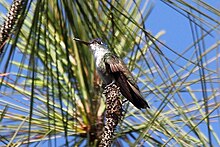Azure-crowned hummingbird
| Azure-crowned hummingbird | |
|---|---|

| |
| Scientific classification | |
| Kingdom: | Animalia |
| Phylum: | Chordata |
| Class: | Aves |
| Order: | Apodiformes |
| Family: | Trochilidae |
| Genus: | Saucerottia |
| Species: | S. cyanocephala
|
| Binomial name | |
| Saucerottia cyanocephala (Lesson, 1829)
| |
| Synonyms | |
|
Ornismya cyanocephalus Lesson, 1829 | |
The azure-crowned hummingbird (Saucerottia cyanocephala) is a species of hummingbird in the family Trochilidae. It is found in Belize, El Salvador, Guatemala, Honduras, Mexico, and Nicaragua. Its natural habitat is subtropical or tropical moist montane forest. The males have a metallic blue crown, while the females are identifiable by a more dull blue or greenish crown.[2] It forages on arthropods (often searching bark and clusters of pine needle) as well as nectar from flowers.[2] The species seems to be territorial based on how available resources are, and like most hummingbirds is likely polygamous.[2] Its nests are generally cup shaped used from local resources, but in an urban setting the species has been known to even use objects such as telephone wires in its construction.[3][4]
This species was formerly placed in the genus Amazilia. A molecular phylogenetic study published in 2014 found that the genus Amazilia was polyphyletic.[5] In the revised classification to create monophyletic genera, the azure-crowned hummingbird was moved to the resurrected genus Saucerottia.[6][7]
Subspecies[]
- Saucerottia cyanocephala cyanocephala (Lesson, 1829)
- Saucerottia cyanocephala chlorostephana Howell, 1965

References[]
- ^ BirdLife International (2012). "Amazilia cyanocephala". IUCN Red List of Threatened Species. 2012. Retrieved 26 November 2013.
- ^ a b c "Azure-crowned Hummingbird". neotropical.birds.cornell.edu. Retrieved 2019-05-25.
- ^ Ornelas, Juan Francisco (September 2010). "Nests, Eggs, and Young of the Azure-crowned Hummingbird (Amazilia cyanocephala)". The Wilson Journal of Ornithology. 122 (3): 592–597. doi:10.1676/09-155.1. ISSN 1559-4491. S2CID 85766188.
- ^ MacGregor-Fors, Ian; Escobar-Ibáñez, Juan F. (June 2015). "On a Tightrope: Use of Open Sky Urban Telephone Wires by Azure-crowned Hummingbirds (Amazilia cyanocephala) for Nesting". The Wilson Journal of Ornithology. 127 (2): 297–302. doi:10.1676/wils-127-02-297-302.1. ISSN 1559-4491. S2CID 83981874.
- ^ McGuire, J.; Witt, C.; Remsen, J.V.; Corl, A.; Rabosky, D.; Altshuler, D.; Dudley, R. (2014). "Molecular phylogenetics and the diversification of hummingbirds". Current Biology. 24 (8): 910–916. doi:10.1016/j.cub.2014.03.016. PMID 24704078.
- ^ Stiles, F.G.; Remsen, J.V. Jr.; Mcguire, J.A. (2017). "The generic classification of the Trochilini (Aves: Trochilidae): Reconciling taxonomy with phylogeny". Zootaxa. 4353 (3): 401–424. doi:10.11646/zootaxa.4353.3. PMID 29245495.
- ^ Gill, Frank; Donsker, David; Rasmussen, Pamela, eds. (July 2020). "Hummingbirds". IOC World Bird List Version 10.2. International Ornithologists' Union. Retrieved 8 January 2020.
- IUCN Red List least concern species
- Saucerottia
- Hummingbird species of Central America
- Birds of Belize
- Birds described in 1829
- Hummingbird stubs
